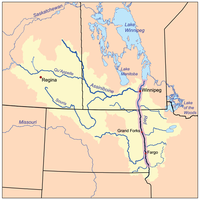| Part of a series on the |
| Red River of the North |
|---|
 |
| Major Floods |
| Geology |
| Infrastructure |
| Related Topics |
The Red River Valley is a region in central North America that is drained by the Red River of the North; it is part of both Canada and the United States. Forming the border between Minnesota and North Dakota when these territories were admitted as states in the United States, this fertile valley has been important to the economies of these states and to Manitoba, Canada.
The population centers of Moorhead, Minnesota, Fargo and Grand Forks, North Dakota, and Winnipeg, Manitoba developed in the valley as settlement by ethnic Europeans increased in the late nineteenth century. Completion of major railroads, availability of cheap lands, and forceful removal of Indigenous people as well as a subsequent refusal to recognize Indigenous land claims attracted many new settlers. Some developed large-scale agricultural operations known as bonanza farms, which concentrated on wheat commodity crops.
Paleogeographic Lake Agassiz laid down the Red River Valley Silts. The river flows north through a wide ancient lake plain to Lake Winnipeg. The geography and seasonal conditions can produce devastating floods, with several recorded since the mid-20th century.